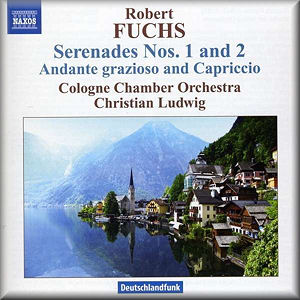 |
 |
| 

alternatively
CD: MDT
AmazonUK
AmazonUS
Sound
Samples & Downloads |
Robert FUCHS
(1847-1927)
Serenade No. 1 in D major, Op. 9 (1874) [19:51]
Serenade No. 2 in C major, Op. 14 (1876) [16:08]
Andante grazioso and Capriccio, Op. 63 (1900) [17:37]
Andante grazioso [7:14]
Capriccio [10:20]
 Cologne Chamber Orchestra/Christian Ludwig
Cologne Chamber Orchestra/Christian Ludwig
rec. 11-15 November 2008, 6 March 2009, Deutschlandfunk, Sendesaal
des Funkhauses, Cologne, Germany. DDD
 NAXOS 8.572222 [53:23]
NAXOS 8.572222 [53:23] 
|
|
|
One might think that Naxos, who have a well-deserved reputation
for rehabilitating forgotten composers, have all but exhausted
that particular avenue. Not so, as their busy release schedule
confirms; for instance, they almost single-handedly revived
the fortunes of Alfredo Casella, whose symphonies and other
orchestral works have been well reviewed on these pages. The
Austro-Hungarian Robert Fuchs, a new addition to this growing
list, was a composer and teacher whose pupils included Mahler,
Sibelius, Wolf and Korngold. But what of his music?
In his liner-notes Anthony Short reports that Brahms, who wasn’t
known for praising young composers, spoke in glowing terms of
Fuchs. The reason for that isn’t hard to find, for the works
recorded here inhabit much the same Classical-Romantic middle
ground as Brahms. As string serenades go – one thinks of contemporary
examples from Tchaikovsky and Dvorįk – the first has a freshness
and bounce that’s most engaging. The opening Andante
is especially mobile, the Cologne band playing with a judicious
blend of passion and refinement. The recording is full and close,
the upper strings fatigue-free, the bass a little stolid.
No matter, for this is delightful stuff. The Minuet is nicely
sprung with the central Scherzo now grave now ardent. Conductor
Christian Ludwig adopts sensible speeds that keep the music
flowing very well; indeed, there are no longueurs to
speak of, but then Fuchs isn’t tempted to overwork his material.
It’s the rhythmic vitality of this music that makes the most
impact. The is Adagio given a light, freewheeling character.
Only in the darker textures of the Finale is there a hint of
Romantic angst – not to mention a distinctly Mahlerian
flavour to the harmonies. Still, this is essentially Classical
in structure and feel, and none the worse for that.
The fact that Fuchs dedicated his second serenade to an Austro-Hungarian
nobleman – shades of Papa Haydn – reinforces the sense that
he belongs to an earlier, more traditional musical/social milieu.
That said, this piece is blessed with the same virtues as its
predecessor, from a nicely aerated Allegretto – the well-blended
upper strings crisp yet lyrical – through to a gravely beautiful
Larghetto, a brightly lit, ebullient Allegro and
a somewhat Mendelssohnian Finale.
Not surprisingly, the fin-de-sičcle Andante grazioso and
Capriccio is much more gnarly and inward. Gone is the carefree
charm of the serenades, although there are sudden shafts of
light in the Andante grazioso and moments of real animation
in the Capriccio. This music sounds more chamber-like
in its intensity and focus. The lower strings – somewhat blurred
in the serenades – are now more trenchant. That’s especially
true of the Capriccio, where they have splendid passion
and bite.
A most enjoyable selection, winningly played and well worth
exploring. Indeed, this has whetted my appetite for the other
Fuchs recordings in the series; what better recommendation than
that?
Dan Morgan
|
|

